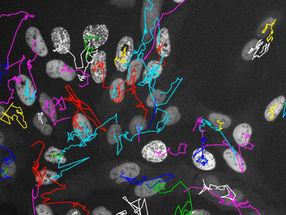Nanocouriers transport molecular cargo
A train-like system that transports molecular cargo between specific pick-up and delivery zones on a chip has been created by Swiss scientists. The technology could lead to nanoscale assembly lines, or improved self-healing materials, they say.
The team already had a working system where a microtubule is propelled along a carpet of motor proteins inside a chip: the ‘train’ and ‘train track’. To improve their system, Claudia Schmidt and Viola Vogel have added ‘departure and arrival stations’.
The researchers labelled the cargo with stretches of DNA and placed complementary strands on the pick-up and delivery stations. By tuning the length of the DNA strands on the stations, and the geometry of the interactions, the strength of the different interactions can be controlled as can the force needed to break them. The relative strengths of the interactions mean that cargo cannot be collected at the delivery station and so it doesn’t make the reverse trip. This ensures the cargo is collected at the pick-up station and deposited at the delivery station.
Developing systems that use nanomotors to move molecular cargos around inside nanoscale devices has become popular recently. As unlike random diffusion, cargo can be moved against a concentration gradient and in contrast to microfluidic devices, an external electrical supply or pump isn’t needed for the transportation.
Original publication: Claudia Schmidt and Viola Vogel; Molecular shuttles powered by motor proteins: loading and unloading stations for nanocargo integrated into one device"; Lab on a Chip,2010, 10, 2195.
Most read news
Organizations
Other news from the department science

Get the life science industry in your inbox
By submitting this form you agree that LUMITOS AG will send you the newsletter(s) selected above by email. Your data will not be passed on to third parties. Your data will be stored and processed in accordance with our data protection regulations. LUMITOS may contact you by email for the purpose of advertising or market and opinion surveys. You can revoke your consent at any time without giving reasons to LUMITOS AG, Ernst-Augustin-Str. 2, 12489 Berlin, Germany or by e-mail at revoke@lumitos.com with effect for the future. In addition, each email contains a link to unsubscribe from the corresponding newsletter.






















































